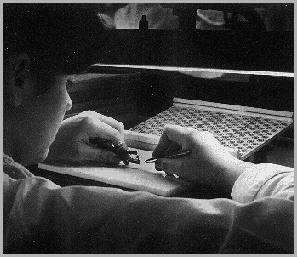 |
The Visitor 2
Production starts in a drawing
office
|
|
|
From design to production
One of the first places to visit on any works tour
is the drawing office, for it is here that production really
begins. Here is most complete equipment to enable the complex
work called for by the production of a new calibre or the modification
of an existing one to go forward as smoothly as possible. The
enormous amount of work involved in bringing any new calibre
to the production stage is demonstrated by the huge array of
drawings in the drawing office files. |
|
For instance, when a new calibre is being designed, the main
features and dimensions are first drawn out, and then every detail
has to be carefully considered, not only from the angle of the
movement itself, but also from the production standpoint. Some
otherwise satisfactory part or process may present technical
difficulties in manufacture that must be met by a careful modification,
and that, in turn, may well raise another point calling for much
thought. |
|
|
When the drawings are, at length, finally approved, a model of
the calibre is made by hand, and carefully tested and scrutinised
to see what further problems it reveals - for there are sure
to be some! With these points dealt with, the drawing office
next sets to work on the drawings for the tools needed to produce
the calibre, which can call for as much work as the drawings
of the movement itself |
|
|
The basic raw materials required for production in a watch factory
are the same the world over - brass and steel rod and plate in
a variety of sizes and thicknesses. Gurnos Works holds an ample
supply in an efficiently laid-out store, with a continuous stock
record. That, however, is not the lend of the story. Every consignment
of steel or brass received is rigidly sampled and tested before
it is approved for storage in the issuing section of the department
as a first step in the quality control that runs through the
whole work of production. |
|
Centring
and flattening |
 From the
quiet orderliness of the stores, the visitor passes to the more
active orderliness of the press and automatic shops. There is
something strangely attractive about the long rows of machines,
each busy with its own details of manufacture. It is like a strange
orchestra of industry, in which the machines have their little
solo piece, such as the cutting of a slot, or the shaping of
a groove, carried out by some special attachments that comes
into action at the right instant every time. From the
quiet orderliness of the stores, the visitor passes to the more
active orderliness of the press and automatic shops. There is
something strangely attractive about the long rows of machines,
each busy with its own details of manufacture. It is like a strange
orchestra of industry, in which the machines have their little
solo piece, such as the cutting of a slot, or the shaping of
a groove, carried out by some special attachments that comes
into action at the right instant every time. |
|
|
The long rows of automatics, which include examples of Bechler,
Petermann and B.S.A. machines, are arranged in long lines in
echelon formation. To stand at one end and glance along the spotless
array is to be impressed by the importance attached to cleanliness.
Precise results are only attainable by rigidly enforced maintenance
in spotless surroundings. |
|
|
There are 7 pages on the visit in 1962.
Use the box links below to see the other pages |
 |
       |
 |

|

 From the
quiet orderliness of the stores, the visitor passes to the more
active orderliness of the press and automatic shops. There is
something strangely attractive about the long rows of machines,
each busy with its own details of manufacture. It is like a strange
orchestra of industry, in which the machines have their little
solo piece, such as the cutting of a slot, or the shaping of
a groove, carried out by some special attachments that comes
into action at the right instant every time.
From the
quiet orderliness of the stores, the visitor passes to the more
active orderliness of the press and automatic shops. There is
something strangely attractive about the long rows of machines,
each busy with its own details of manufacture. It is like a strange
orchestra of industry, in which the machines have their little
solo piece, such as the cutting of a slot, or the shaping of
a groove, carried out by some special attachments that comes
into action at the right instant every time.